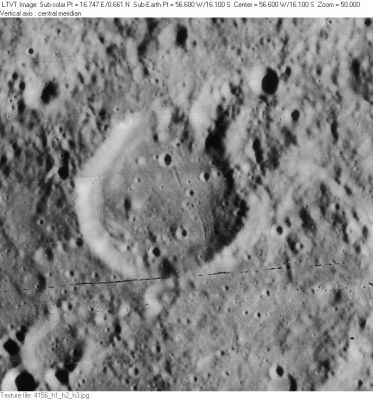Fontana
Contents
Fontana
|
Lat: 16.07°S, Long: 56.76°W, Diam: 31.47 km, Depth: 1.13 km, [/R%C3%BCkl%2051 Rükl: 51] |
Table of Contents

LO-IV-156H
Images
LPOD Photo Gallery Lunar Orbiter Images
Maps
([/LAC%20zone LAC zone] 92B1) LAC map Geologic map
Description
Elger
([/IAU%20Directions IAU Directions]) FONTANA.--A noteworthy ring-plain, about 20 miles in diameter, W.N.W. of [/Zupus Zupus], with a bright border, exhibiting a narrow gap on the S. and two large contiguous craters on the N.E. The faint central mountain stands on a dusky interior. On the N. is a large peculiar depressed plain with a gently sloping wall, within which are three short rill-like valleys and a crater.
Wikipedia
Additional Information
- IAU page: Fontana
- Depth data from [/Kurt%20Fisher%20crater%20depths Kurt Fisher database]
- Westfall, 2000: 1.13 km
Nomenclature
- Named for Francesco Fontana (c. 1585-1646), an Italian astronomer who built telescopes which he felt rivaled or exceed those of Galileo. Fontana, a lawyer by trade, published a number of maps of the Moon, including at least 28 illustrations of different phases which [/Whitaker Whitaker] refers (p. 47 and 49, perhaps unjustly) as "wildly imaginative (and inaccurate!)". Some of his images reportedly appeared in books published by others. - JimMosher JimMosher
- The entire text of Fontana's Novae coelestium is available in the ETH's e-rara and in the IMSS Digital Library.
- Start of Lunar section on e-rara.
- A few pages, including Fontana's celebrated full disk map can be found at the University of Oklahoma.
- More samples.
- The entire text of Fontana's Novae coelestium is available in the ETH's e-rara and in the IMSS Digital Library.
LPOD Articles
Bibliography
- Fontana, Francisco. 1646. Novae coelestium terrestriumque rerum observationes. Naepoli: Gaffarus.
Fontana in the Sourcebook Project (William R. Corliss)
- In Mysterious Universe, a handbook of astronomical anomalies (1979) :
- Page 141: The Problematical Satellite of Venus (Observatory, 1884).
- Page 142: The Supposed Satellite of Venus (Observatory, 1887).
Note: these two articles are from the days when the so-called moon of Venus ("Neith") was a hot topic in the astronomical world.
[/Alphabetical%20Index Named Featues] -- Prev: [/Rimae%20Focas Rimae Focas] -- Next: [/Fontenelle Fontenelle]
This page has been edited 1 times. The last modification was made by - tychocrater tychocrater on Jun 13, 2009 3:24 pm - afx3u3